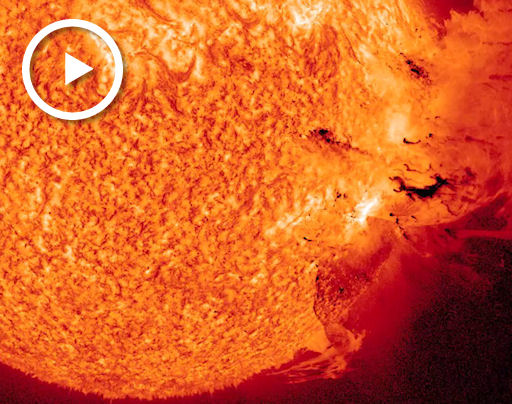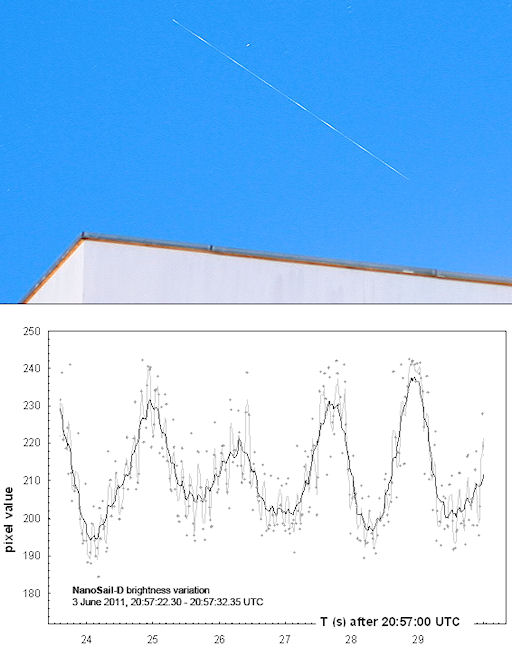STORM WARNING: NOAA forecasters estimate a greater than 25% chance of geomagnetic storms on June 9th. That's when a CME from the magnificent flare of June 7th is expected to deliver a glancing blow to Earth's magnetic field. High-latitude sky watchers should be alert for auroras. Aurora alerts: voice, text.
MAGNIFICENT FLARE: On June 7th at 0641 UT, magnetic fields above sunspot complex 1226-1227 became unstable and erupted. The resulting blast produced an M2-class solar flare, an S1-class radiation storm, and an unbelievable movie:
Credit: NASA's Solar Dynamics Observatory.
"It looks like someone kicked a clod of dirt in the air," says solar physicist C. Alex Young of NASA's Goddard Space Flight Center in a Youtube video. "I've never seen material released in this way before--an amazing, amazing event."
Much of the plasma thrown up by the blast simply fell back to the sun--indeed, that's what makes the footage so dramatic. In the movies you can see blobs of hot gas as large as Earth making bright splashes where they hit the stellar surface. Some plasma, however, reached escape velocity and left the sun in the form of a coronal mass ejection: movie. Traveling faster than 1100 km/s, the CME should deliver a glancing blow to Earth's magnetic field during the late hours of June 8th or June 9th. High-latitude sky watchers should be alert for auroras when the CME arrives.
NANOSAIL-D IN BRIGHT TWILIGHT: NASA's Nanosail-D, the first solar sail to orbit Earth, is catching the attention of evening sky watchers. "I saw it on June 3rd in bright evening twilight (sun at -7 degrees altitude)," reports Marco Langbroek of Leiden, the Netherlands. "The sky was still light blue, with the first stars visible. NanoSail-D became very bright, flashing periodically to mag. 0 with a slightly variable flash interval of 1.2 - 1.5 seconds." Look below the snapshot for a time history of the sail's brightness:
Because high-resolution photography of the small sail is so challenging, mission scientists can't be 100% sure how NanoSail-D is oriented or why it is flashing. Probably it is tumbling, with glints of sunlight producing quiasi-periodic "solar sail flares." NanoSail-D will be strobing across the evening skies of Europe and North America this week. Check the Simple Satellite Tracker or your cell phone for flyby times.



















Статус: |
Группа: Гости
публикаций 0
комментариев 0
Рейтинг поста:
Минувшим днем астрономы зафиксировали на Солнце мощнейший выброс энергии за последние пять лет. Поток плазмы, вырвавшись из недр светила наружу, напоминал исполинскую огненную медузу либо комок грязи, подброшенный кем-то ввысь и затем плюхнувшийся на поверхность звезды, рассказали ученые NASA. Опускаясь, плазменный гриб накрыл почти половину солнечного диска.
"Это было довольно драматичное зрелище, - уточнил координатор американского Центра прогнозирования космических явлений Билл Мерта. - Первоначальные вспышки были относительно невелики по сравнению с вызванным ими извержением протуберанцев. Мы зафиксировали мощный поток радиоактивных частиц и рассчитали, что масса выброса была весьма существенной".
Солнечный шторм продолжался более трех часов подряд, информирует Daily Mail. По утверждению астрофизиков и метеорологов, это явление можно отнести к событиями среднего масштаба, которое не представляет серьезной угрозы для искусственных спутников Земли и наземного оборудования. Тем не менее самая мощная вспышка, зафиксированная с 2006 г., все же не обойдется без последствий.
Уже сегодня, 8 июня специалисты прогнозируют начало очередной геомагнитной бури. Она будет выражаться, преимущественно, северными сияниями, а ее активный период продлится 12 - 24 часа. Эксперты Национальной метеорологической службы США предупреждают, что магнитная активность может отразиться на работе навигационного оборудования и расписании авиарейсов. Кроме того, магнитные бури скажутся на здоровье метеочувствительных людей, которые в ближайшие дни могут ощущать ухудшение самочувствия.
Напомним, не так давно Солнце "пробудилось" от пассивной фазы своего 11-летнего цикла, в результате чего поверхность звезды то и дело приходит в возмущение. Солнечные бури характеризуются вспышками, которые сопровождаются резким всплеском электромагнитного излучения. Достигнув Земли, оно ионизирует внешние слои атмосферы. По достижении геостационарной орбиты эти частицы бомбардируют чувствительную электронику, спутники связи и нередко выводят эти аппараты из строя.
Магнитные бури, случившиеся в феврале - марте, были самыми сильными за последние годы. По словам ученых, геомагнитные возмущения могут вызывать сбои в работе радиосвязи и линий электропередачи. Поэтому некоторые даже связали вспышки на Солнце с разрушительным землетрясением, произошедшим в Японии 11 марта.
Многие ученые смотрят на эти события с нескрываемым пессимизмом. Так, в конце мая руководитель Института космических исследований (ИКИ) РАН Лев Зеленый заявил, что увеличение солнечной активности грозит человечеству техногенными проблемами уже в 2012 году. И если в ближайшее время подобные беды могут свалиться на США и Канаду, то впоследствии главный удар придется на российскую территорию. "Со временем, лет через 50 - 70, активность Солнца будет оказывать все большее влияние на территорию России, в частности, Сибири, куда будет смещаться так называемая "геомагнитная шапка", - подчеркнул Зеленый.
Не добавляют спокойствия и другие явления, в последние недели проходящие вокруг нашего светила. Очередной всплеск солнечной активности был зафиксирован в прошлом месяце, после того как в Солнце врезалась огромная комета. Столкновение сопровождалось мощным взрывом и колоссальным выбросом солнечной энергии.
Постоянный адрес статьи:
http://www.utro.ru/articles/2011/06/08/979108.shtml